Abstract
Although the toxicity of lead was recognized centuries ago, concern was restricted to overt symptoms: colic, encephalopathy, anemia, or renal disease. Two major reasons for lack of progress in restricting toxicity were that interest was limited to occupational exposures and there was lack of awareness of specific biochemical or metabolic effects. Identification of subclinical effects has been possible the last 15 or 20 years because of the development of sensitive measures to detect cognitive and behavioral changes that are not apparent clinically and because of methods to measure the reduced activity of heme enzymes. This progress was driven by basic and clinical research that resulted in a better understanding of cellular toxicology. The new awareness prompted the lowering of acceptable occupational exposures, as measured by blood lead from 80 to 40 to 60 micrograms/dL range, and the establishment of maximum recommended exposures in children to a blood lead level of 25 micrograms/dL. Lowering the lead content in gasoline has been accomplished by a nearly 50% decrease in average blood levels of persons in the United States (NHANES II data). Current research implicates lead as a contributing etiologic factor in a number of common diseases affecting large portions of the population such as subtle cognitive and neurological deficits, hypertension, congenital malformations, immunotoxicity, and deficits in growth and development. For each of these disorders there may be multiple etiologic factors; the scientific challenge is to develop sensitive methodology to detect the specific role of lead. Other potential subtle health effects include the influence of small amounts of lead on cell proliferation and lead as a cofactor in carcinogenesis.(ABSTRACT TRUNCATED AT 250 WORDS)
Full text
PDF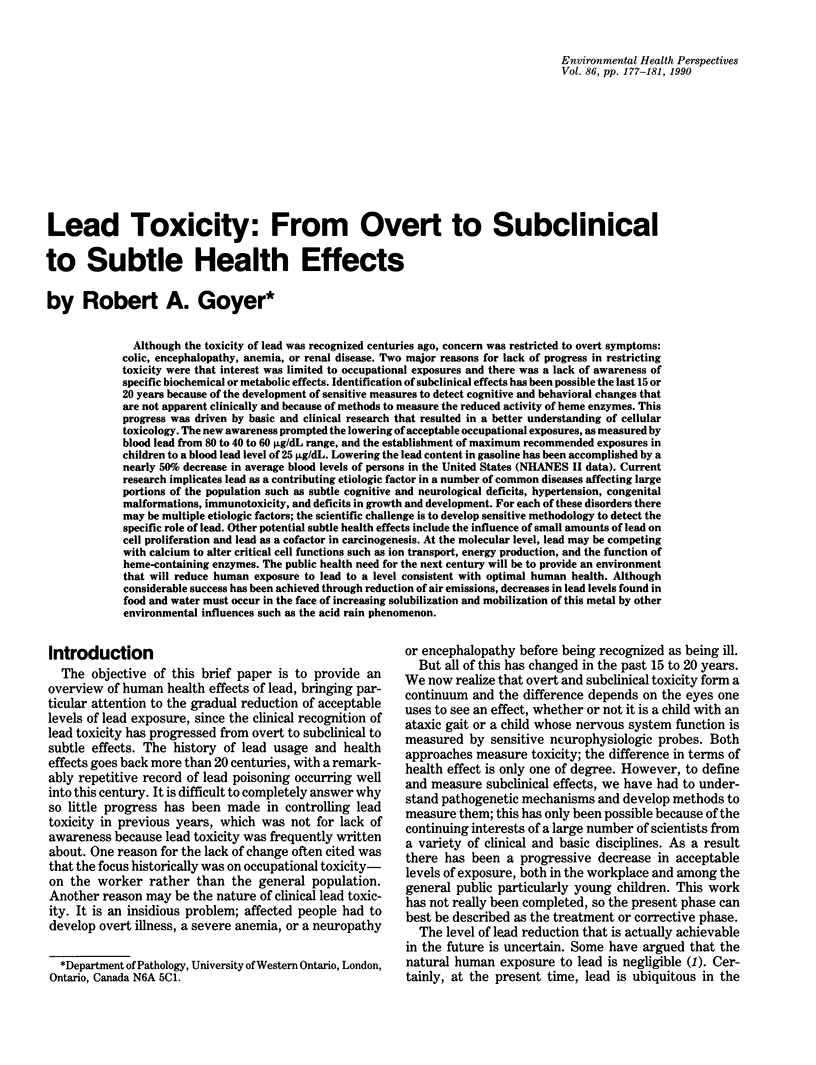
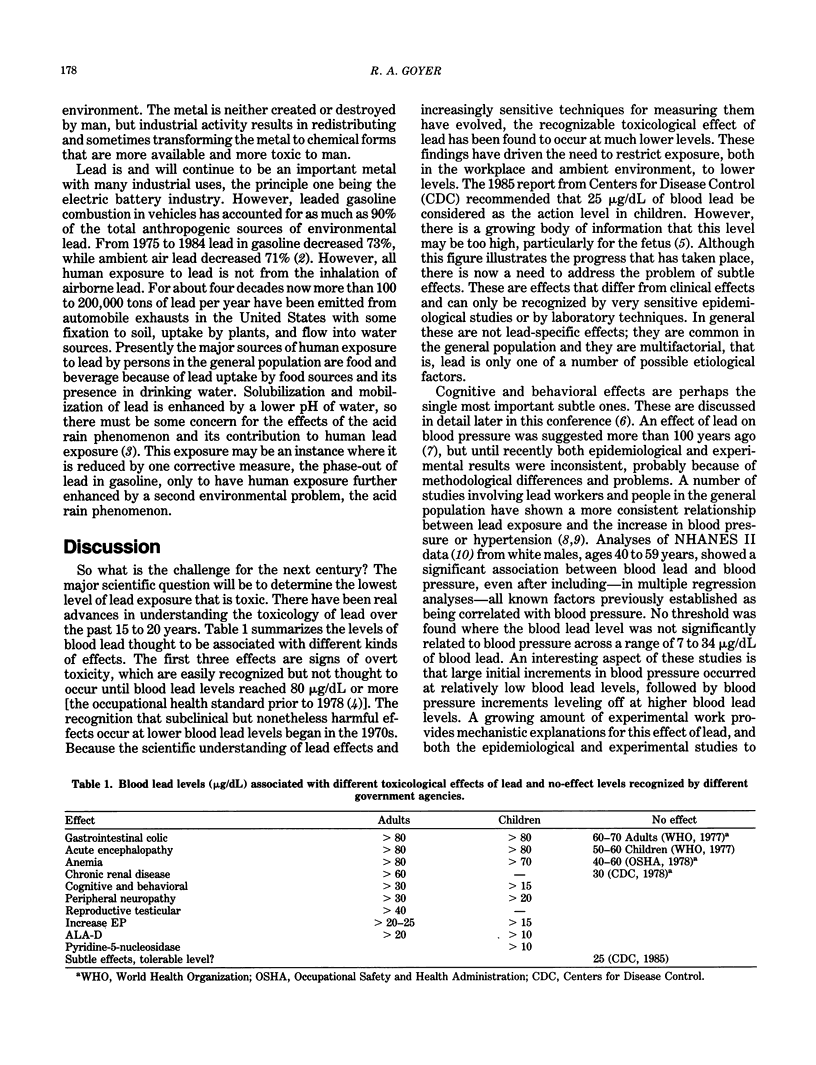
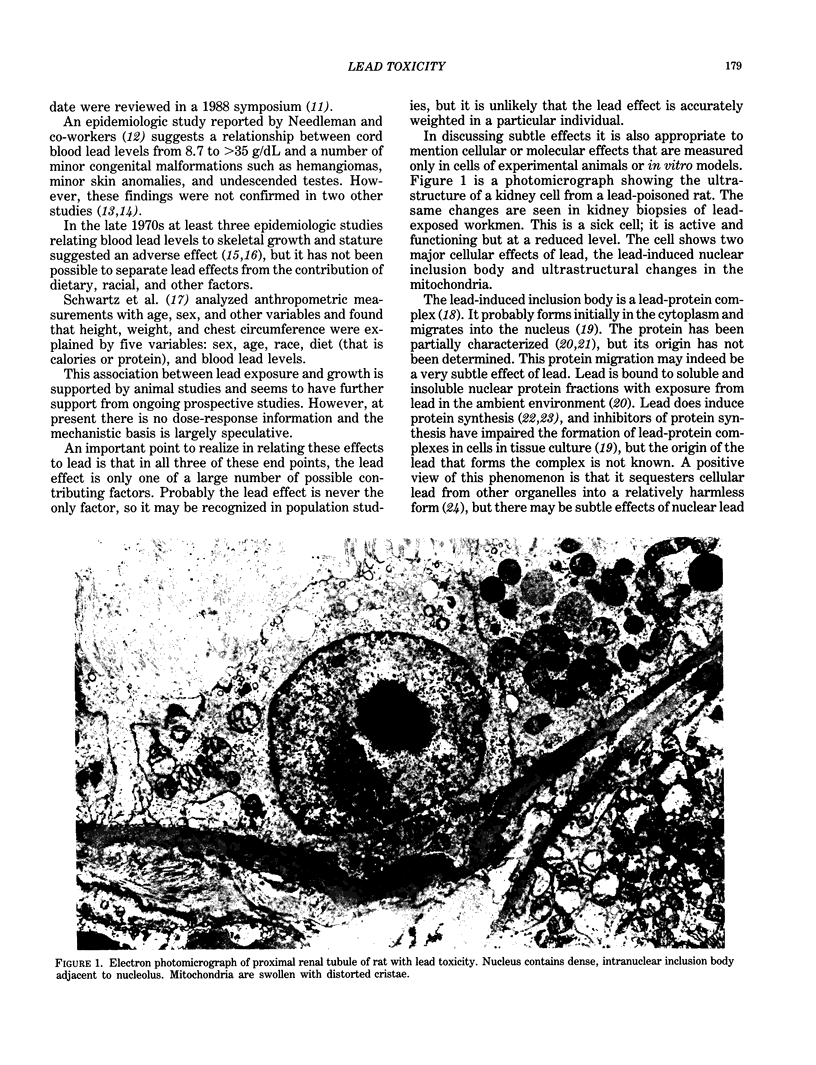
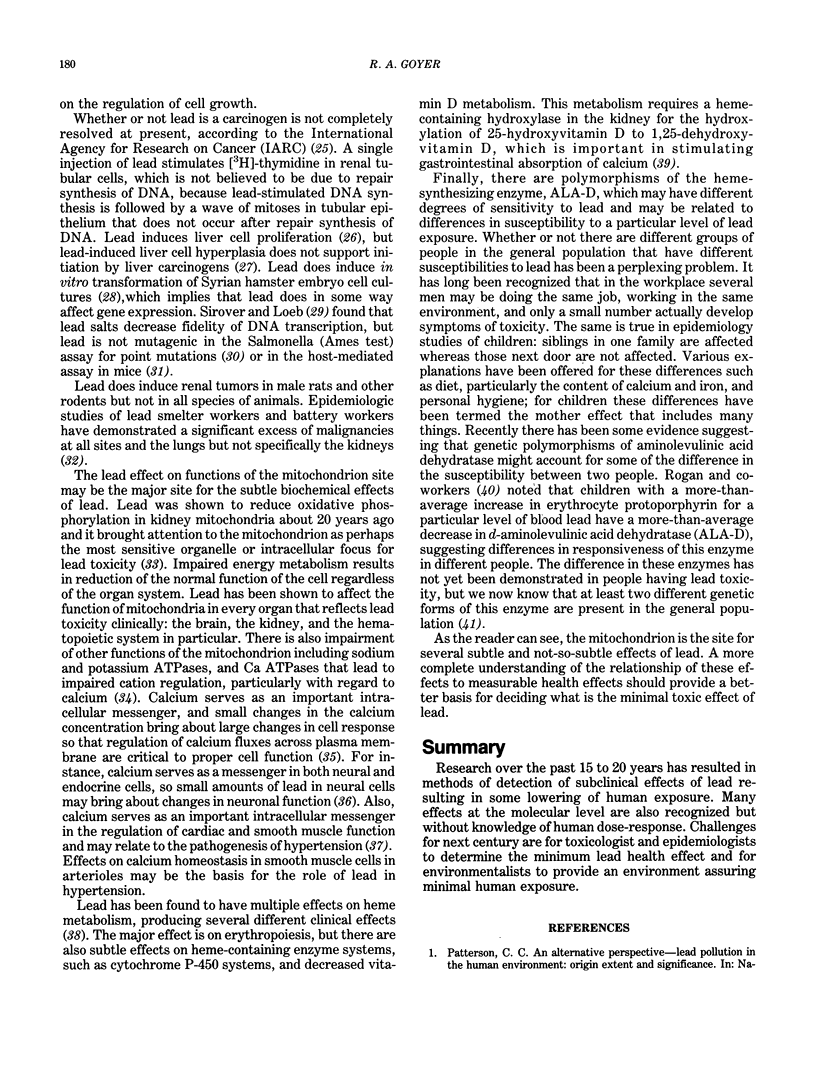
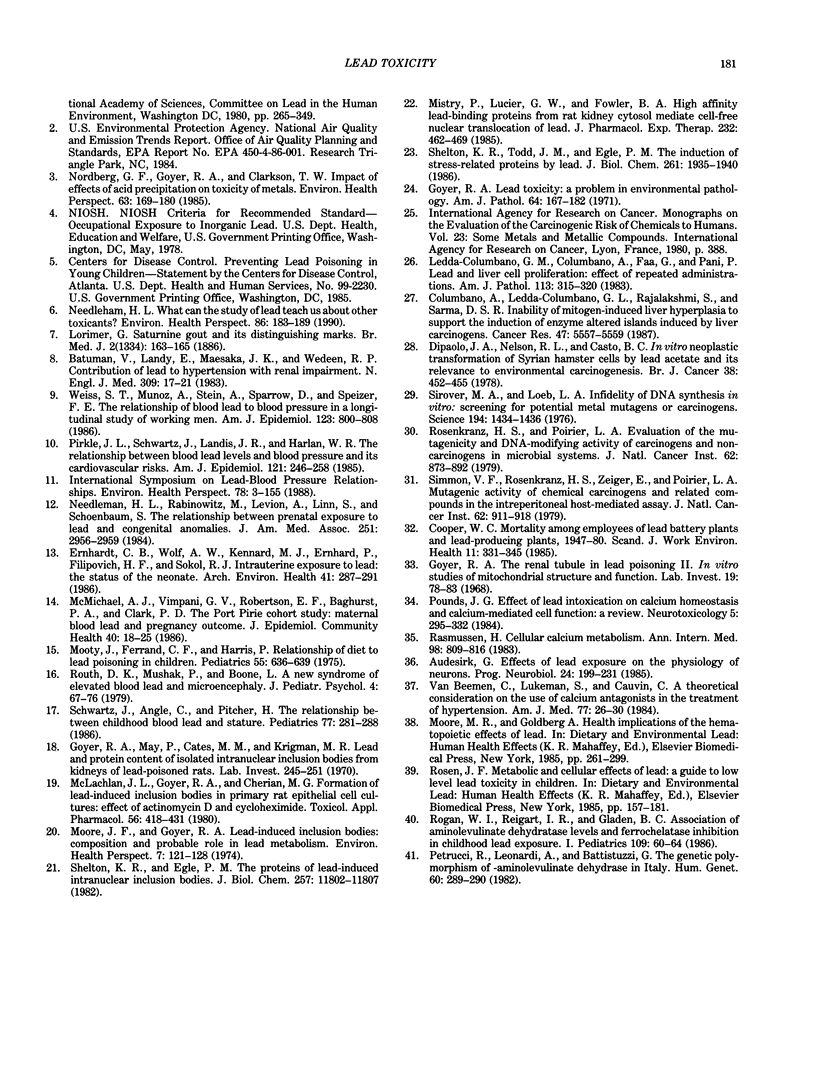
Images in this article
Selected References
These references are in PubMed. This may not be the complete list of references from this article.
- Audesirk G. Effects of lead exposure on the physiology of neurons. Prog Neurobiol. 1985;24(3):199–231. doi: 10.1016/0301-0082(85)90006-1. [DOI] [PubMed] [Google Scholar]
- Batuman V., Landy E., Maesaka J. K., Wedeen R. P. Contribution of lead to hypertension with renal impairment. N Engl J Med. 1983 Jul 7;309(1):17–21. doi: 10.1056/NEJM198307073090104. [DOI] [PubMed] [Google Scholar]
- Columbano A., Ledda-Columbano G. M., Lee G., Rajalakshmi S., Sarma D. S. Inability of mitogen-induced liver hyperplasia to support the induction of enzyme-altered islands induced by liver carcinogens. Cancer Res. 1987 Nov 1;47(21):5557–5559. [PubMed] [Google Scholar]
- Cooper W. C., Wong O., Kheifets L. Mortality among employees of lead battery plants and lead-producing plants, 1947-1980. Scand J Work Environ Health. 1985 Oct;11(5):331–345. doi: 10.5271/sjweh.2215. [DOI] [PubMed] [Google Scholar]
- Dipaolo J. A., Nelson R. L., Casto B. C. In vitro neoplastic transformation of Syrian hamster cells by lead acetate and its relevance to environmental carcinogenesis. Br J Cancer. 1978 Sep;38(3):452–455. doi: 10.1038/bjc.1978.228. [DOI] [PMC free article] [PubMed] [Google Scholar]
- Ernhart C. B., Wolf A. W., Kennard M. J., Erhard P., Filipovich H. F., Sokol R. J. Intrauterine exposure to low levels of lead: the status of the neonate. Arch Environ Health. 1986 Sep-Oct;41(5):287–291. doi: 10.1080/00039896.1986.9936698. [DOI] [PubMed] [Google Scholar]
- Goyer R. A., Krall A., Kimball J. P. The renal tubule in lead poisoning. II. In vitro studies of mitochondrial structure and function. Lab Invest. 1968 Jul;19(1):78–83. [PubMed] [Google Scholar]
- Goyer R. A. Lead toxicity: a problem in environmental pathology. Am J Pathol. 1971 Jul;64(1):167–182. [PMC free article] [PubMed] [Google Scholar]
- Ledda-Columbano G. M., Columbano A., Pani P. Lead and liver cell proliferation. Effect of repeated administrations. Am J Pathol. 1983 Dec;113(3):315–320. [PMC free article] [PubMed] [Google Scholar]
- McLachlin J. R., Goyer R. A., Cherian M. G. Formation of lead-induced inclusion bodies in primary rat kidney epithelial cell cultures: effect of actinomycin D and cycloheximide. Toxicol Appl Pharmacol. 1980 Dec;56(3):418–431. doi: 10.1016/0041-008x(80)90076-9. [DOI] [PubMed] [Google Scholar]
- McMichael A. J., Vimpani G. V., Robertson E. F., Baghurst P. A., Clark P. D. The Port Pirie cohort study: maternal blood lead and pregnancy outcome. J Epidemiol Community Health. 1986 Mar;40(1):18–25. doi: 10.1136/jech.40.1.18. [DOI] [PMC free article] [PubMed] [Google Scholar]
- Mistry P., Lucier G. W., Fowler B. A. High-affinity lead binding proteins in rat kidney cytosol mediate cell-free nuclear translocation of lead. J Pharmacol Exp Ther. 1985 Feb;232(2):462–469. [PubMed] [Google Scholar]
- Moore J. F., Goyer R. A. Lead-induced inclusion bodies: composition and probable role in lead metabolism. Environ Health Perspect. 1974 May;7:121–127. doi: 10.1289/ehp.747121. [DOI] [PMC free article] [PubMed] [Google Scholar]
- Mooty J., Ferrand C. F., Harris P. Relationship of diet to lead poisoning in children. Pediatrics. 1975 May;55(5):636–639. [PubMed] [Google Scholar]
- Needleman H. L., Rabinowitz M., Leviton A., Linn S., Schoenbaum S. The relationship between prenatal exposure to lead and congenital anomalies. JAMA. 1984 Jun 8;251(22):2956–2959. [PubMed] [Google Scholar]
- Needleman H. L. What can the study of lead teach us about other toxicants? Environ Health Perspect. 1990 Jun;86:183–189. doi: 10.1289/ehp.9086183. [DOI] [PMC free article] [PubMed] [Google Scholar]
- Nordberg G. F., Goyer R. A., Clarkson T. W. Impact of effects of acid precipitation on toxicity of metals. Environ Health Perspect. 1985 Nov;63:169–180. doi: 10.1289/ehp.8563169. [DOI] [PMC free article] [PubMed] [Google Scholar]
- Petrucci R., Leonardi A., Battistuzzi G. The genetic polymorphism of delta-aminolevulinate dehydrase in Italy. Hum Genet. 1982;60(3):289–290. doi: 10.1007/BF00303023. [DOI] [PubMed] [Google Scholar]
- Pirkle J. L., Schwartz J., Landis J. R., Harlan W. R. The relationship between blood lead levels and blood pressure and its cardiovascular risk implications. Am J Epidemiol. 1985 Feb;121(2):246–258. doi: 10.1093/oxfordjournals.aje.a113995. [DOI] [PubMed] [Google Scholar]
- Pounds J. G. Effect of lead intoxication on calcium homeostasis and calcium-mediated cell function: a review. Neurotoxicology. 1984 Fall;5(3):295–331. [PubMed] [Google Scholar]
- Rasmussen H. Cellular calcium metabolism. Ann Intern Med. 1983 May;98(5 Pt 2):809–816. doi: 10.7326/0003-4819-98-5-809. [DOI] [PubMed] [Google Scholar]
- Rogan W. J., Reigart J. R., Gladen B. C. Association of amino levulinate dehydratase levels and ferrochelatase inhibition in childhood lead exposure. J Pediatr. 1986 Jul;109(1):60–64. doi: 10.1016/s0022-3476(86)80573-x. [DOI] [PubMed] [Google Scholar]
- Rosenkranz H. S., Poirier L. A. Evaluation of the mutagenicity and DNA-modifying activity of carcinogens and noncarcinogens in microbial systems. J Natl Cancer Inst. 1979 Apr;62(4):873–892. [PubMed] [Google Scholar]
- Schwartz J., Angle C., Pitcher H. Relationship between childhood blood lead levels and stature. Pediatrics. 1986 Mar;77(3):281–288. [PubMed] [Google Scholar]
- Shelton K. R., Egle P. M. The proteins of lead-induced intranuclear inclusion bodies. J Biol Chem. 1982 Oct 10;257(19):11802–11807. [PubMed] [Google Scholar]
- Shelton K. R., Todd J. M., Egle P. M. The induction of stress-related proteins by lead. J Biol Chem. 1986 Feb 5;261(4):1935–1940. [PubMed] [Google Scholar]
- Simmon V. F., Rosenkranz H. S., Zeiger E., Poirier L. A. Mutagenic activity of chemical carcinogens and related compounds in the intraperitoneal host-mediated assay. J Natl Cancer Inst. 1979 Apr;62(4):911–918. [PubMed] [Google Scholar]
- Sirover M. A., Loeb L. A. Infidelity of DNA synthesis in vitro: screening for potential metal mutagens or carcinogens. Science. 1976 Dec 24;194(4272):1434–1436. doi: 10.1126/science.1006310. [DOI] [PubMed] [Google Scholar]
- Van Breemen C., Lukeman S., Cauvin C. A theoretic consideration on the use of calcium antagonists in the treatment of hypertension. Am J Med. 1984 Oct 5;77(4A):26–30. doi: 10.1016/s0002-9343(84)80034-0. [DOI] [PubMed] [Google Scholar]
- Weiss S. T., Muñoz A., Stein A., Sparrow D., Speizer F. E. The relationship of blood lead to blood pressure in a longitudinal study of working men. Am J Epidemiol. 1986 May;123(5):800–808. doi: 10.1093/oxfordjournals.aje.a114309. [DOI] [PubMed] [Google Scholar]



